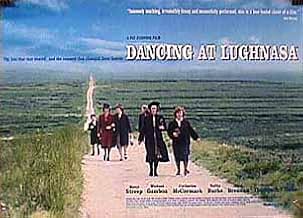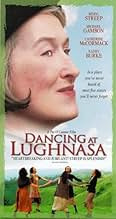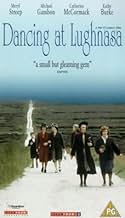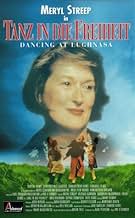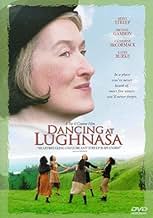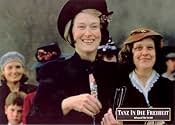AVALIAÇÃO DA IMDb
6,3/10
4,3 mil
SUA AVALIAÇÃO
Cinco irmãs solteiras aproveitam ao máximo sua existência simples na Irlanda rural na década de 1930.Cinco irmãs solteiras aproveitam ao máximo sua existência simples na Irlanda rural na década de 1930.Cinco irmãs solteiras aproveitam ao máximo sua existência simples na Irlanda rural na década de 1930.
- Direção
- Roteiristas
- Artistas
- Prêmios
- 2 vitórias e 7 indicações no total
Gerard McSorley
- Narration by
- (narração)
- Direção
- Roteiristas
- Elenco e equipe completos
- Produção, bilheteria e muito mais no IMDbPro
Avaliações em destaque
This movie version is pleasant enough but does not have the power of the stage play upon which it is based. Spoilt brat that I am, I saw the original production at the RNT in 1990 with the amazing Alec McCowen as Uncle Jack. I am a great fan of Michael Gambon, but he is simply miscast in that role for the movie. Not so Meryl Streep, who does a superb overpowering aunt. The delightful Catherine McCormack and Rhys Ifans do a good job of the love interest. This is nevertheless a shadow of the stage play. My better half liked it, but had not seen the stage version. For lovers of Irish drama the film is worth 90 minutes of your time.
Given the luxury of owning films via DVD collections offers the opportunity to revisit at will the works the viewer found worthy of purchase. Such is the case with the luminous 'Dancing at Lughnasa', a 1998 release by director Pat O'Connor to the tunes of a lilting screenplay by Frank McGuinness based on Brian Friel's 1990 play of the same name. Though low key and not a popular hit at the box office, this is one of those rare films that combines a very simple tale about common folks brought to life by a cast of extraordinary actors.
The story is set in Donnegal, Ireland in 1936 (just before WW II)choked the world) and simply relates the life of a family of five single sisters and the love child of one of them. The action is spare, centering on the visit of their brother home from the missionary work in Uganda inalterably changed from the experience, on the loss of job of the supporting eldest sister, and the return of the errant father of the love child for the summer, and other daily challenges. The stresses and strains these small events play on the sisters is eventually climaxed in the dancing festival that marks the Feast of Lughnasa (a persistent pagan celebration that challenges the very Catholic foundation of the Irish community), a compelling event that parallels the returned priest brother from the mission fields where he has gained insight into the desperate need for community, happiness, dancing and celebration as the essential needs of humankind.
The cast is flawless: Meryl Streep is superb as the elder sister bitterly bound to holding the family together at all costs, Catherine McCormack as the mother of the lovechild, Kathy Burke, Sophie Thompson and Brid Brennan; Michael Gambon as the deranged returned brother; and Rhys Ifans as the errant father of the child. They interact and play like fine chamber music. The brilliantly green and gorgeous countryside is captured eloquently by Kenneth MacMillan. In every aspect of production the film fits like a tightly intertwined puzzle. It simply glows. Revisiting 'Dancing at Lughnasa' is an even finer trip than the first exposure. Highly Recommended.
The story is set in Donnegal, Ireland in 1936 (just before WW II)choked the world) and simply relates the life of a family of five single sisters and the love child of one of them. The action is spare, centering on the visit of their brother home from the missionary work in Uganda inalterably changed from the experience, on the loss of job of the supporting eldest sister, and the return of the errant father of the love child for the summer, and other daily challenges. The stresses and strains these small events play on the sisters is eventually climaxed in the dancing festival that marks the Feast of Lughnasa (a persistent pagan celebration that challenges the very Catholic foundation of the Irish community), a compelling event that parallels the returned priest brother from the mission fields where he has gained insight into the desperate need for community, happiness, dancing and celebration as the essential needs of humankind.
The cast is flawless: Meryl Streep is superb as the elder sister bitterly bound to holding the family together at all costs, Catherine McCormack as the mother of the lovechild, Kathy Burke, Sophie Thompson and Brid Brennan; Michael Gambon as the deranged returned brother; and Rhys Ifans as the errant father of the child. They interact and play like fine chamber music. The brilliantly green and gorgeous countryside is captured eloquently by Kenneth MacMillan. In every aspect of production the film fits like a tightly intertwined puzzle. It simply glows. Revisiting 'Dancing at Lughnasa' is an even finer trip than the first exposure. Highly Recommended.
The acclaimed stage play from Brian Friel has been successfully adapted for the screen in this visual treat from Pat O'Connor. The beautiful landscapes of Donegal do not smother the intelligent performances such as from Meryl Streep (Kate Mundy), Catherine McCormack (Christine Mundy) and Rhys Ifans (Gerry Evans). Those critics who have condemned the movie for being simple and about ordinary people seem to miss the point. This is meant to be a simple story about ordinary people - and that is why it is so moving! More importantly though - 'Dancing at Lughnasa' is also entertaining and really deserved better than the mixed reviews on initial release.
Contemplating suicide? This is just the film for you. It will either put you completely over the top, or convince you that however bad you feel, you might as well live because there are others who are much, much worse off. This is the crushingly sad tale of 5 Irish sisters, each of whom appears to have screwed up any and all chances for personal happiness. Now, stuck together in permanent spinsterhood and extreme poverty, they face economic and personal disaster. Unfortunately, rather than being moved by their plight, I found myself increasingly irritated by their passive reaction to it. Oh yes, if the tragic sisters are not sufficient, there is also the demented, dying brother to cheer things up. Maybe things were really that bad in depression era Ireland. I sincerely hope not. 2 1/2 stars for the scenery and acting.
Watchable but instantly forgettable film of Brian Friel's award-winning play which provides its greatest pleasures through the strong performances of its ensemble cast. Five independent-minded sisters living in Donegal in the mid 1930s face the possibility of change when economic and emotional circumstances conspire against them. The return of their brother from religious missions in Africa signals the beginning, and as the pagan festival of Lughnasa, which celebrates the harvest and forebodes the coming of winter, is celebrated around them, they must come to terms with changes in their own relatively comfortable middle class world. The ten year old son of one of them views events with a nostalgic eye which nonetheless sees the hardship and heartbreak which occurs around him.
Despite director Pat O'Connor's valiant attempts to open out' the play, the film is still extremely theatrical. The inclusion of landscape shots and the restaging of certain scenes in outdoor locations unavailable in the theatre does not really make the film cinematic. It merely adds visuals to what is still a complex series of linguistic exchanges which delineate and explore character. Authentic production design and costuming and the persistent presence of a traditional-themed score by Bill Whelan contribute to the feeling of the film, and with the help of good accent work by the cast, it manages to successfully evoke a feeling of time and place. However it remains an extremely well produced stage play on film, and is still bound by blocking and staging conventions which allow the actors to meet and greet one another to exchange their thoughts and feelings. The closest the film comes to a visual symbolic system is the use of dance and ritual to underscore the social and emotional tensions. The undercurrent of paganism which defines the relationships between people and their sense of the cosmos is constantly evoked (as it was in the play), and the film begins with a credit sequence featuring images of African tribes people in traditional costumes. But other than the climactic dance scene where the sisters celebrate their sisterhood to the strains of ceili music, the film rarely manages to escape the enclosed and cerebral world of the stage version.
But paradoxically, the reliance on actors plying their trade on well written words (rather than visuals) is the thing which saves the film from itself. Meryl Streep gives a convincing performance (and manages a creditable accent) as the repressed, authoritarian schoolteacher who heads the female clan, and she is more than matched by Michael Gambon's endearing performance as the slightly baffled priest whose exposure to the customs and rituals of Africa have coloured his perceptions of home. The rest of the cast (the non-stars, so to speak) are equally good, particularly Sophie Thompson as the simple minded Rose and Kathy Burke as the chain smoking Maggie. Catherine McCormack and Brid Brennan (the latter a veteran of the Abbey Theatre production) have less showy roles, but work distinctive characterisations in with those of the others with ease and skill. Supporting male performances from Rhys Ifans and young Darrell Johnston are also good, and the film also comes with a rich voice over provided by Gerard McSorley (who played the part of the the child at an adult remembering in the stage version).
This aspect of the film alone is probably worth the time and attention required to view it, but on the whole it is a less rewarding experience than the play itself. While an unfair basis upon which to criticise a work of adaptation, the material was perhaps fundamentally unsuited to cinematic treatment. Though Frank McGuinness has done his best to translate the themes and character issues, and has successfully done so insofar as it applies to theme and character, this is not so much a film version as a film of the play with some additional settings and scenes which prevent it from becoming completely unwatchable. What power it has comes from the power of the play, and it is mostly evinced at the level of verbal discourse. Theatrical adaptation is a minefield for film makers and has produced varying results in the past. Dancing at Lughnasa does not distinguish itself in the annals of this sub-section of film history, but for those patient enough with its lack of genuine cinematic interest, it offers certain pleasures which should pass the time painlessly enough.
Despite director Pat O'Connor's valiant attempts to open out' the play, the film is still extremely theatrical. The inclusion of landscape shots and the restaging of certain scenes in outdoor locations unavailable in the theatre does not really make the film cinematic. It merely adds visuals to what is still a complex series of linguistic exchanges which delineate and explore character. Authentic production design and costuming and the persistent presence of a traditional-themed score by Bill Whelan contribute to the feeling of the film, and with the help of good accent work by the cast, it manages to successfully evoke a feeling of time and place. However it remains an extremely well produced stage play on film, and is still bound by blocking and staging conventions which allow the actors to meet and greet one another to exchange their thoughts and feelings. The closest the film comes to a visual symbolic system is the use of dance and ritual to underscore the social and emotional tensions. The undercurrent of paganism which defines the relationships between people and their sense of the cosmos is constantly evoked (as it was in the play), and the film begins with a credit sequence featuring images of African tribes people in traditional costumes. But other than the climactic dance scene where the sisters celebrate their sisterhood to the strains of ceili music, the film rarely manages to escape the enclosed and cerebral world of the stage version.
But paradoxically, the reliance on actors plying their trade on well written words (rather than visuals) is the thing which saves the film from itself. Meryl Streep gives a convincing performance (and manages a creditable accent) as the repressed, authoritarian schoolteacher who heads the female clan, and she is more than matched by Michael Gambon's endearing performance as the slightly baffled priest whose exposure to the customs and rituals of Africa have coloured his perceptions of home. The rest of the cast (the non-stars, so to speak) are equally good, particularly Sophie Thompson as the simple minded Rose and Kathy Burke as the chain smoking Maggie. Catherine McCormack and Brid Brennan (the latter a veteran of the Abbey Theatre production) have less showy roles, but work distinctive characterisations in with those of the others with ease and skill. Supporting male performances from Rhys Ifans and young Darrell Johnston are also good, and the film also comes with a rich voice over provided by Gerard McSorley (who played the part of the the child at an adult remembering in the stage version).
This aspect of the film alone is probably worth the time and attention required to view it, but on the whole it is a less rewarding experience than the play itself. While an unfair basis upon which to criticise a work of adaptation, the material was perhaps fundamentally unsuited to cinematic treatment. Though Frank McGuinness has done his best to translate the themes and character issues, and has successfully done so insofar as it applies to theme and character, this is not so much a film version as a film of the play with some additional settings and scenes which prevent it from becoming completely unwatchable. What power it has comes from the power of the play, and it is mostly evinced at the level of verbal discourse. Theatrical adaptation is a minefield for film makers and has produced varying results in the past. Dancing at Lughnasa does not distinguish itself in the annals of this sub-section of film history, but for those patient enough with its lack of genuine cinematic interest, it offers certain pleasures which should pass the time painlessly enough.
Você sabia?
- CuriosidadesOriginal choices to star were Frances McDormand and Kate Winslet.
- Erros de gravaçãoThe radio is one of the first ever made, so it's a tube radio, which would not be able to come on instantly like the later transistor radios; it would have needed a while to warm up before there would be any sound from it.
- Citações
Kate 'Kit' Mundy: I am a righteous bitch, amn't I?
- Cenas durante ou pós-créditosDuring the opening credits, stills of African tribal dances and of Jack as priest in Africa are shown.
Principais escolhas
Faça login para avaliar e ver a lista de recomendações personalizadas
Detalhes
- Data de lançamento
- Países de origem
- Central de atendimento oficial
- Idioma
- Também conhecido como
- O Baile de Agosto
- Locações de filme
- Empresas de produção
- Consulte mais créditos da empresa na IMDbPro
Bilheteria
- Faturamento bruto nos EUA e Canadá
- US$ 2.287.818
- Fim de semana de estreia nos EUA e Canadá
- US$ 83.759
- 15 de nov. de 1998
- Faturamento bruto mundial
- US$ 2.287.818
- Tempo de duração1 hora 35 minutos
- Cor
- Mixagem de som
- Proporção
- 1.85 : 1
Contribua para esta página
Sugerir uma alteração ou adicionar conteúdo ausente

Principal brecha
By what name was A Dança das Paixões (1998) officially released in India in English?
Responda


